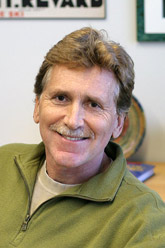
Handy Links
SLAC News Center
SLAC Today
- Subscribe
- Archives: Feb 2006-May 20, 2011
- Archives: May 23, 2011 and later
- Submit Feedback or Story Ideas
- About SLAC Today
SLAC News
Lab News
- Interactions
- Lightsources.org
- ILC NewsLine
- Int'l Science Grid This Week
- Fermilab Today
- Berkeley Lab News
- @brookhaven TODAY
- DOE Pulse
- CERN Courier
- DESY inForm
- US / LHC
SLAC Links
- Emergency
- Safety
- Policy Repository
- Site Entry Form

- Site Maps
- M & O Review
- Computing Status & Calendar
- SLAC Colloquium
- SLACspeak
- SLACspace
- SLAC Logo
- Café Menu
- Flea Market
- Web E-mail
- Marguerite Shuttle
- Discount Commuter Passes
-
Award Reporting Form
- SPIRES
- SciDoc
- Activity Groups
- Library
Stanford
Around the Bay
From the Director of LCLS: LCLS Update

In my last SLAC Today column on October 9, 2009, I reported about the start of experiments at the Linac Coherent Light Source. We on the LCLS team can now say that the first experimental run from October 1 to December 18, 2009 was a resounding success. LCLS has proven that it can deliver X-rays with the properties we had hoped for, and our users have already used them to create exotic states of matter such as atoms without electrons, and recorded images of invisibly small nano objects with only a single, ultrashort flash of X-rays. I would guess you are all eager to hear more and are anxious to read about some great discoveries made at LCLS.
Not so fast! While the recorded data are safely stored on computer disks, the scientists are still busy analyzing them or are in the process of writing up the first results for publication. Unfortunately, there are no sneak previews. Understandably, the experimental teams hold their cards close to their chests. It is not just you and the public that is kept in the dark—even LCLS management is given limited information. Since many of the results truly represent "firsts" and contain information that could not be obtained before LCLS, the experimental teams aim to publish them in the top scientific journals. Those journals want to publish the results with a bang, so they typically require information to remain embargoed until publication. Therefore we all have to wait…
Fortunately, in the meantime there are other things to write about. The number of proposals received for LCLS experiments is steadily increasing. The first solicitation in September 2008 for beam time in the fall of 2009 yielded 28 proposals involving 219 scientists. The second round in May 2009 for the upcoming May–September 2010 beam time produced 62 proposals involving 469 scientists. This week, we have our Proposal Review Panel in town to evaluate and rank 107 LCLS proposals involving 672 scientists, received in November 2009 for beam time starting in October of this year. All in all, LCLS has already 860 unique users from 25 countries and we have only advertised the availability of half of our six experimental stations. The final three stations will not start operation until 2011.
Another exciting development is SLAC's submission to the Department of Energy of a Mission Need Statement for an LCLS upgrade, called LCLS-II. The statement lays out the scientific case for enhanced capabilities offered by LCLS-II. Before LCLS is even finished as a construction project, the bold plan for LCLS-II is made possible by the early success of LCLS, which can now serve as a reliable platform for future improvements. The remarkable performance of LCLS, which has already exceeded its design goal, inspires the development of novel concepts, and the "mission need" is fuelled by the large user demand and excitement in the scientific community.
LCLS-II is part of a joint SLAC-Lawrence Berkeley National Laboratory "West Coast strategy" to assemble a complete suite of X-ray sources in the San Francisco Bay area. We envision that in 10 years or so, a scientific user flying into San Francisco can either drive south to Stanford or across the bay to Berkeley to gain access to world-leading X-ray facilities. The plan includes upgrades to the Advanced Light Source at Berkeley and the Stanford Synchrotron Radiation Lightsource at SLAC, and envisions construction of a high-repetition-rate soft X-ray free electron laser at LBNL. I believe that nobody can blame us for thinking too small!
